Max Allan Collins's Blog, page 47
March 28, 2017
How to Make Me Smile
As you may have gathered, if you’ve stopped by here at all frequently, I am a collector of movies on Blu-ray and DVD. Many of my favorite films have made it onto Blu-ray, like Kiss Me Deadly and Gun Crazy (though I had to get that from Germany). And a fairly short list of my favorites remain on DVD only, like the Chinatown sequel, The Two Jakes, and the great film version of the Broadway musical, Li’l Abner.
One of my favorites, poorly represented with a terrible transfer on DVD, has finally made it to Blu-ray, in a limited edition of 3000, from Twilight Time, the boutique label that has brought us any number of terrific films, from The Big Heat to the Hammer Hound of the Baskervilles, from a Sinatra Tony Rome double feature to Pretty Poison.
But this time – and my birthday month yet – they have given me (and Barb and for that matter son Nate, who also loves it) a film I could watch once a week – How to Succeed in Business Without Really Trying.

There are those who can find reasons not to like this movie, just as there are people who can find a reason not to like ice cream. They are to be pitied. How to Succeed features a brilliant, witty, acid but not hateful score by the brilliant Frank Loesser. A Pulitzer Prize-winning musical (yes, Pulizter Prize-winning musical) in 1961, the Broadway version skewered the shallowness of big business in an up-to-the-moment manner. Unfortunately, the timing of the film’s release – 1967 – made How to Succeed’s cutting-edge satire seem dated, a lot having happened since ‘61.
Fortunately, time has been kind to this early ‘60s musical, with its bright Batman TV colors and cartoon images come to life (cartoonist Virgil Partch – VIP – was a consultant) and Bob Fosse choreography that is as witty and biting as the original play itself. (Fosse is not the actual choreographer of the film, but he’s credited as the source.)
A number of players from the Broadway show are retained, including Michelle Lee (who was the second Rosemary Pilkington in the original cast), the very funny Rudy Vallee, Ruth Kobart, and Sammy Smith, with Charles Nelson Reilly’s Bud Frump M.I.A., though decently replaced by Anthony Teague. Maureen Arthur – a live-action Little Annie Fannie – was in the national company of the musical and joined the Broadway run later.
I saw the national company in Chicago when I was in high school and fell in love with the musical then. The cast included Dick Kallman as Finch (later star of Hank on TV), who was excellent, with the second Great Gildersleeve, Willard Watterman, in the Rudy Vallee role. And of course the eye-popping Maureen Arthur was Hedy LaRue (“O.K. Charlie!”).
Two things make this film one of the best transitions of a Broadway hit to the big screen. First, director/writer David Swift – with credits like Pollyanna and Under the Yum Yum Tree enough to make one doubtful – had the surprising sense to film faithfully a show that had won seven Tony Awards, the New York Drama Critics Circle award, and the 1962 Pulitzer Prize for Drama.
The other thing is Robert Morse.
His J. Pierrepont Finch is my favorite performance in any musical film. He shamelessly recreates the Broadway role with only the slightest concession to movie technique. He understands, as does the rest of the cast (though not on this level), that he’s appearing in a cartoon. His character, who climbs from window washer to the chairman of the board in a few days, following a self-help book that provides the film’s narration – should be unsympathetic. He’s manipulative and dissembling and is never seen really working (not really trying, remember?); but the boyishness of Morse himself smooths the edge off.
Morse brings a remarkable energy to his songs and his loose-limbed dancing brings James Cagney to mind. In the ensemble, “Brotherhood of Man,” in the midst of a sea of Bob Fosse choreography, brilliant scene-stealer Morse knows just how to draw the viewer’s eye, chiefly by lagging like a jazz player behind the melody just enough to seem improvisional among all the precise dancers. He alone seems spontaneous.

Does he mug? Almost constantly. His performance is basically Jerry Lewis Goes to Graduate School. Somehow, playing a ladder-climbing nogoodnik, he seems joyful – the perfect conveyer of Loesser’s lyrics, with their hidden dark side.
Famously, the big hit love song from How to Succeed is sung by Morse’s Finch…to himself in a mirror. Few scores rival this one, though like Sondheim, Loesser writes to the story. The songs that were left out (“Paris Original,” “Happy to Keep His Dinner Warm”) are the weakest in the show. The only loss, besides Charles Nelson Reilly, is the great “Coffee Break,” which was filmed but cut for time. Too bad it doesn’t seem to have survived to be a special feature.
Morse and Reilly, by the way, were so successful on Broadway that they made an album together, “A Jolly Theatrical Season,” in 1963.
If the name Robert Morse seems vaguely familiar to smart younger people, he played Bertram Cooper on Mad Men, a role he was cast in, in tribute to his star turn in How to Succeed. Toward the end of Mad Men’s run, Morse was given a lovely song-and-dance farewell.
Morse’s career on Broadway was a stellar one, particularly his roles in Sugar and his one-man play, Tru, in which he played Truman Capote, winning his second Tony. But his film legacy is, largely, How to Succeed. No other film caught his magic, and a few really did him no favors – Honeymoon Hotel; Quick, Before It Melts – though The Loved One and Guide for the Married Man are worthy credits. I used to feel sad that this great talent had only one film to do him justice.
But with How to Succeed finally on Blu-ray, and with Mad Men as a wonderful, Emmy-nominated coda, I can only smile.
Nice modern-day (separate) interviews with Morse and Michelle Lee are special features. No “Coffee Break,” alas.
Buy it here.
* * *
The Writers Workshop at the University of Iowa gives its mystery-writer black sheep some nice recognition.
And here’s a lovely look at Road to Perdition the film.
M.A.C.
March 21, 2017
Passings
Three show business figures passed away recently, and as it happens, I had passing meetings with each.
CHUCK BERRY, 90, I met at an airport where we shared a gate. He was traveling with a guitar in its case, and appeared to be alone. But it was unmistakably him. As a longtime veteran of rock ‘n’ roll, I had to have a moment. I didn’t ask for an autograph, afraid I might start trouble for him, because a lot of people obviously didn’t recognize him.
“I just want to thank you for starting it all,” I said.
He smiled and said you’re welcome, and we shook hands.
I think I said something about having played rock ‘n’ roll for decades, and he said where he was headed, though I’ve forgotten. He was quiet but friendly.
What I said to him was about right. Little Richard and other black artists of the early rock days really were r & b starting to become rock, and Elvis fell in that category as well. But Chuck Berry, with his guitar-driven rock and his teenage subject matter, was not r & b, but at the very forefront of the new genre. Pure rock ‘n’ roll.
He was playing regularly in his home, St. Louis, until very recently.
TONY ROSATO, 62, is one of the unsung heroes of SCTV. He and the great Robin Duke were in the final season of the original incarnation of the show (they both moved to SNL after). His big character on the show was TV chef Marcello Sebastiani, but he was also a fine mimic, playing Lou Costello in a memorable Abbott and Elvis Costello parody.

He had a fine career, with a lot of Canadian TV, but mental health problems took him into a tragic area in later years.
I met him at the SCTV reunion in Chicago several years ago, in a crowded lobby of fans and Second City performers. He was accompanied by a minder of sorts and was obviously feeling a little lost. He was frankly surprised when I recognized him and asked for an autograph, which he gave me, and he smiled when I told him what a big fan I was of his SCTV and SNL work.
ROBERT OSBORNE, 84, the charming and knowledgeable presenter on Turner Classic Movies, I met backstage (actually upstairs somewhere) at a theater in Hollywood. My pal Leonard Maltin was giving me a chance to meet Jane Powell and a few other celebrities at the TCM Film Festival that year. I chatted with Osborne about (this will surprise few) how cool it would be to have a Mickey Spillane film festival on TCM, as they’d already shown The Girl Hunters a few times and Kiss Me Deadly many times. He was friendly and gracious, and exactly the guy you saw on TV.
I thanked him for everything he did for classic films and for sharing his enthusiasm, and knowledge, with viewers. And I’m glad I did.
While I never met him, BILL PAXTON, 61, was a good friend of my pal Bill Mumy and appeared in “Fish Heads” (which he also directed) and other Barnes & Barnes videos. What a terrific actor, and what a devastating loss. If you’ve never watched his HBO series Big Love, you should correct that mistake.
I don’t recall meeting the great cartoonist BERNIE WRIGHTSON, who like me was born in March of 1948, but I loved his work. Decades ago, when I started realizing interesting new things were happening in comics, and that I wasn’t the only one who liked the medium, Bernie Wrightson was at the forefront.
Such passings define bittersweet – we are so lucky to have experienced the art these creators shared with us, and so unlucky to be denied any more.
* * *
For those who suspect I have become a curmudgeon where current movies are concerned, walking out more often than staying to the finish, I am pleased to report Barb and I saw a terrific movie this weekend – Get Out.
Written and directed by Jordan Peele, Get Out is a horror movie with darkly satiric overtones and some outright comedy that never dampens a truly creepy tale that might be described as an African-American Stepford Wives…though that doesn’t do it justice.
Remember how lousy I said the script of Kong was? And how I was chastised for expecting a monster movie to have good dialogue? Well, he’s a horror movie on a modest budget with no huge stars (but a strong cast) that not only has sharp dialogue but a well-constructed narrative that pays off everything it sets up, in a most satisfying manner.
This one I’ll be buying on Blu-ray.
* * *
The Will to Kill, the new Spillane/Collins, is getting some lovely reviews. Have you ordered your copy yet? What are you waiting for? You wanna get on Mike Hammer’s bad side? In the meantime, check out this wonderful Criminal Element review.
And here’s another great Will to Kill review, this one from the NY Journal of Books.
The new Hard Case Crime edition of Quarry’s Vote inspired this sweet review.
And Publisher’s Weekly likes Antiques Frame, due out in about a month.
Finally, once again my Eliot Ness/Batman graphic novel of some time ago is getting noticed.
M.A.C.
March 14, 2017
A Gig, a Walk-Out, and More
Saturday night Crusin’ played for a benefit at the River Music Experience in Davenport. The cause was music education in the Muscatine school system. This was our first gig of the year (by choice), having last played in September for my high school 50th class reunion.
It was just an hour but felt good – nice to be back on stage with the guys, and our guitarist Jim Van Winkle’s son, Teddy, played trombone with us on a couple of songs. Teddy is a music major at the University of Iowa and really tore it up. This my first time performing since lung surgery, and I was of course concerned, but had no problems with either stamina or singing.
We have about half a dozen gigs lined up through the summer and fall.

* * *
I am rather astonished to report that Barb and I walked out of a movie again, one we had been looking forward to all week. Kong – Skull Island has a high Rotten Tomatoes rating, and my pal Leonard Maltin loved it. We didn’t. The script was terrible – cringe-worthy dialogue and a ponderous set-up, and a cast that couldn’t overcome either. Tom Hiddleson, with his narrow face and slight build, is presented as some kind of bar brawler, which is unbelievable even without the notion that this makes him vital to a team going out to track monsters. John Goodman has lost so much weight, he looks ill, as if he’s wearing a baggy skin suit, and Samuel Jackson glowering at Kong and Kong glowering back has an uncomfortable racist tinge. Your results may vary, but we gave it fifty minutes before it got so stupid we couldn’t even stay to watch a bunch of characters we hated get killed.
Barb passed on Logan, but I saw it with Nate a weekend ago, and found it okay, with the trio of actors at its center (Hugh Jackman, Patrick Stewart and Dafne Keen) strong. Self-importantly dark and almost entirely humorless, Logan also suffers from underwhelming villains in actors Boyd Holbrook and Richard E. Grant, the former silly in his villainy, the latter hammy as an evil scientist. No Ian McKellan or Michael Fassbender in sight.
Some of you are suspecting I don’t like anything any more. But I like lots of things, mostly on TV, including lately Rowan Atkinson’s Maigret (and Michael Gambon’s and Bruno Cremer’s), the fourth season of Endeavor (the Morse prequel) and the Victoria series, though I wish it didn’t want to be Downton Abbey so bad.
* * *
My editor at Hard Case Crime, Charles Ardai, is so fast and efficient I sometimes think I’m hallucinating. Less than a week after I turned in Quarry’s Climax, he gave me edits and then galley proofs, and the book is put to bed.
No sign of a second Quarry TV season, though there’s been no official cancellation.
I am working on the non-fiction book Scarface & the Untouchable, the joint Capone/Ness bio. It promises to be major, but brother is it tough. My co-authors Brad Schwartz and George Hagenauer have written their rough draft material and gathered research, and now I’m up to bat.
Looks like the manuscript could be in the 1200 – 1500 page range. Like we say in the funnies, gulp.
* * *

Now in Paperback!




If you are going to Bouchercon this year, and have been sent an Anthony ballot, and like my work enough to be reading this, here’s a reminder of what’s eligible:
Road to Perdition: The New Expanded Version, paperback original.
The Nate Heller novel, Better Dead, hardcover.
Quarry in the Black, paperback.
Murder Never Knocks, hardcover.
Antiques Fate, hardcover.
“A Dangerous Cat,” Hammer short story in the Strand.
* * *
The Will to Kill is out and I hope some of you have already bought this new Mike Hammer by Mickey and me, and that the rest of you will do so soon. We need reviews at Amazon and elsewhere, including blogs, and your participation would be much appreciated.
Michael Carlson has done a most interesting Will to Kill review in his UK column, Irresistible Targets.
Also out in (mass-market paperback) is Hammer’s last year’s performance, Murder Never Knocks. Here’s a great Ron Fortier review of it.
Finally, here’s a Quarry’s Choice audio review, very nice.
M.A.C.
March 7, 2017
New Mike Hammer Novel
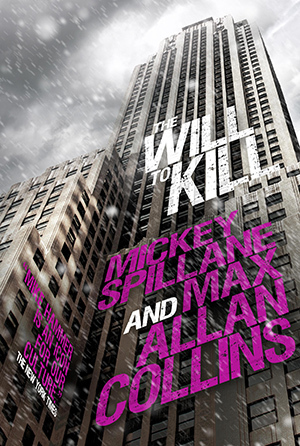
Hardcover:




E-Book:




Available March 14, The Will to Kill is the ninth Mike Hammer novel I’ve completed from material in Mickey Spillane’s files.
Most people taking the time to read this weekly update already know that Mickey, in the last weeks of his life, asked me to complete his final Hammer novel in progress, The Goliath Bone, and that he told his wife Jane to round up everything in his files that wasn’t completed and give it to me – that “Max would know what to do.”
No greater honor has ever been paid me. Mickey’s work, which I discovered at age 13, was what made me transfer my enthusiasm for becoming a cartoonist to an obsession with becoming a writer…specifically, a writer of tough mystery fiction. Ironically, Mickey had been a comic book writer before the Mike Hammer novels turned him into a superstar, and one of the major projects we did together was a comic book – a science fiction variation on Hammer called Mike Danger (the original name for Hammer in the unsold comic book Mickey created right after the war that he turned into the novel I, the Jury).
I had six substantial Hammer manuscripts to deal with – usually around 100 pages (of 300) and sometimes notes on plot and character, and even roughed-out endings. In some cases Mickey had told me what ending he had in mind for an uncompleted book. (Mickey’s shocking surprise endings were his trademark, or anyway one of them.)
A number of very short (two to five page) fragments became short stories, published in various magazines, and were collected last year as A Long Time Dead: A Mike Hammer Casebook. If you’ve never read a Hammer story, that’s a great place to start.
Another half dozen significant unfinished manuscripts remained, and so far they have become the novels Kill Me, Darling; Murder Never Knocks; and now The Will to Kill. Both Darling and Knocks are out in mass-market paperback now – Knocks came out in that format about a week ago. (I am contracted to do three more.)
The Will to Kill is an unusual Hammer, as Bill Crider’s review indicates. (See link below.) Before the success of I, the Jury, featuring what was then a shocking amount of sex and violence, Mickey appeared to have in mind for his private detective a more traditional approach. But the vengeance aspect of the surprise bestseller-list response to I, the Jury sent him down a path of Hammer rarely taking a client, and usually being on a mission of I’ll-find-the-killer-and-kill-him (or her).
I had only the first couple of chapters of The Will to Kill to deal with from Mickey, and while the opening is shocking, the set-up is like something out of Agatha Christie – a bunch of spoiled rich grown kids chasing their late daddy’s fortune in the mansion they share. In about thirty pages, Mickey set up the entire book and its characters. There are aspects that aren’t anything you’d find in Poirot or Miss Marple – a serial killer targeting young women who are on vacation in the Catskills (the setting of the story) – but Hammer is doing a favor for his cop pal, Pat Chambers, looking into the wealthy man’s “accidental death”…not seeking vengeance for a murdered friend (tip: don’t be Mike Hammer’s friend in a Mickey Spillane novel, unless you’re Pat Chambers).
I like the book a lot. It was fun and somewhat challenging to keep the novel and its main character feeling right in a story unusual for them. This is not to say that a bad guy or two don’t get bumped off by the impetuous hero, who also thumps some nasties who deserve it, here and there. And beautiful women come along, too, so…so it’s still Mike Hammer, and I hope you’ll also think it’s a lot of fun.
By the way, the murder victim that starts the story up is the rich man’s butler. So this may be an old-fashioned mystery, but the butler definitely did not do it.
* * *
The new Quarry novel – Quarry’s Climax – has been delivered to editor Charles Ardai at Hard Case Crime. Charles is crazy fast and has already read, and approved, the book.
Usually I take a few weeks off between projects, but because of my various health issues last year, I fell desperately behind, and now must move immediately from one project to another, until I catch up.
Well, I still plan to take a few days off between finishing one project and starting another. We spent the weekend – my 69th birthday weekend (!) – with our son Nate and grandson Sam and daughter-in-law Abby. A lovely time. Sam is the cutest child I’ve ever seen, and I’m sure his resemblance to me hasn’t colored my opinion.
This week I start Scarface and the Untouchable, the massive dual bio of Al Capone and Eliot Ness. My co-authors, A. Brad Schwartz and George Hagenauer, have delivered their rough drafts of their respective sections (Brad, Ness; George, Capone) reflecting incredible, groundbreaking research on both their parts. My job: not screw it up.

Nate and Sam Collins
* * *
Here’s Bill Crider’s lovely Will to Kill review.
Check out this nice review of the early Quarry novel, Quarry’s Deal, from the UK.
Here’s an article about fifteen people other than Bruce Wayne who have been Batman – and wait till you see who’s number one! Hint: more late-coming unexpected love for my Batman work.
Finally, more nice words about the Quarry TV series.
M.A.C.
March 1, 2017
March Kindle Sale
Now through the end of March, the “Disaster” series is available on the Kindle store for 99 cents each, along with two Mallory novels and Triple Play, a Nathan Heller casebook. Complete your collection, or stock up for some rainy day reading. The covers below link directly to each purchase page on Amazon.
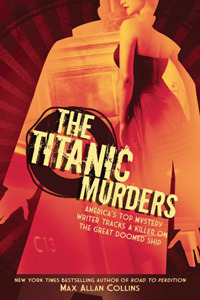
The Titanic Murders
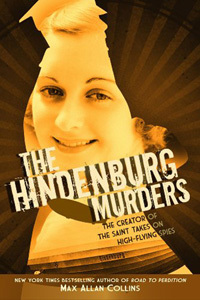
The Hindenburg Murders

The Pearl Harbor Murders
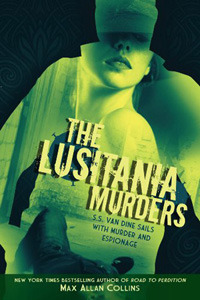
The Lusitania Murders
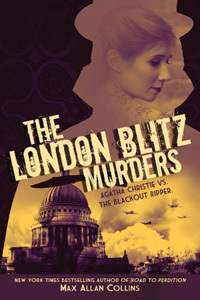
The London Blitz Murders
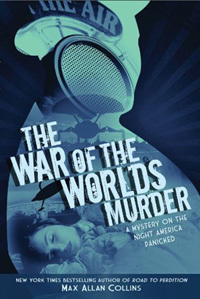
The War of the Worlds Murder

No Cure for Death
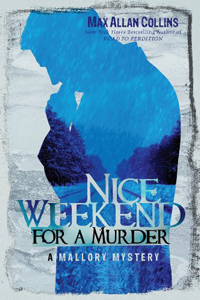
Nice Weekend for a Murder
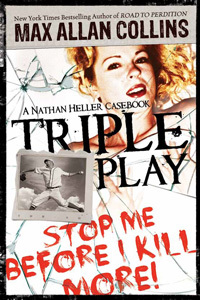
Triple Play: A Nathan Heller Casebook
February 28, 2017
The Column I Wrote Instead of Watching the Oscars
As I take a breath from finishing up my novel Quarry’s Climax, here are a few capsule movie reviews. Prepare to be enlightened and enraged….
The usual four-star rating format:
The Lego Batman Movie – ***. I wrote briefly about this earlier, and those who’ve been paying attention already know how heavily this film leans on my character the Mime. This is a terrific and often very funny film, superior to any Batman film in recent memory (including the so-dark Bale ones). Its only problems are a length that wears out its welcome for young kids and older folks particularly, and a tendency to so fill the screen with so much action as to be dizzying. The theme of family is also a bit heavy-handed, but this return to a non-dark Batman with fun villainy and self-deprecating humor is a welcome one…at least it is for this former Batman writer and fan of the comic book for a good decade before Adam West and Burt Ward came onto the Bat-channel. (For some of us, the shark repellant gags were the best in the film.)
The Great Wall – * 1/2. A lot wrong with this one. What’s right is its epic nature and the very sweep of the thing, so credit that much to director Zhang Yimou (of the overrated House of Flying Daggers). What’s wrong includes a terrible script (six screenwriters – not a good sign!), English-speaking actors given no direction by the Chinese director (Matt Damon spends the film in pursuit of an Irish accent), and a lot of pro-Communist propaganda laughable in its ham-handedness. Hilarious to see the Red Chinese preach against greed while plotting to take greenbacks out of red-white-and-blue pockets. The monsters are rather ugly in their CGI design, another rehash of the Raptors from Jurassic Park Parts Whatever. Back before mainland China took over Hong Kong, there was a vibrant Chinese film culture, including John Woo’s crime dramas, Jackie Chan’s adventure films and such wonderful fantasies as the Chinese Ghost Story films and David Chung’s I Love Maria. Now we get this empty spectacle.

John Wick: Chapter 2 – **** The first Wick movie was the best action film of its year, and this year will find the sequel hard to top. Even if you’re already seen it, watching the first John Wick before taking this one in will be helpful – very nice resonances and returning characters. It’s over the top and people who hate guns will be in the wrong theater. Wick is a modern-day samurai who is driven by vengeance (again) in an almost science-fiction world where contract killers inhabit a secret society of their own. It’s as good as James Bond movies ought to be, and the action sequences – with the understated but very funny and yet scary Keanu Reeves doing almost all of his stunts – is depicted minus the missing frames and frantic editing that turn such sequences into utter incoherence in almost all other modern action films. You can follow what’s going on! What an innovation.
Resident Evil: The Final Chapter. *** I know I’m supposed to hate a movie like this. It does indeed have incomprehensible action scenes at times (well, more just at times). But the video-game-based film series anticipated the zombie craze and has specialized in making social comments through a genre film in a way that clearly eludes the Red Chinese. At the heart of the series and this (supposedly) final entry is charismatic Milla Jovovich, a strong female protagonist if there ever was one. In 3-D this played overly dark, and many of the secondary characters didn’t particularly register. But – unlike The Great Wall, with its evil puppy dog creatures swarming the barricades – the zombies here are a tangible, scary presence, and when they swarm, they really swarm. Also, the many threads of the five films that precede it are cleverly tied up and for once an X-Files-type “all will be revealed” promise is kept.
Manchester by the Sea – no rating. I’m not giving this a rating because I didn’t finish it. I gave it around forty minutes. I know of really smart people, many smarter than me most likely, who rave about this picture. And some of the acting, particularly the justifiably lauded Casey Affleck, is admirable. But the movie is a painfully slow soap opera. Slowing it down seems to be part of what fools people. What we have here is the story of a sad guy whose beloved brother dies, saddling him with a surrogate son in a nephew. Seems the sad guy got sad after he accidentally burned his little kids to death in a fire, which caused his wife to hate him. Scenes include driving in slow traffic to get to the hospital, and another visiting the brother’s dead body in the hospital morgue. I guess I’m not supposed to notice that the kid actors sitting around talking about Star Trek in the wake of their friend’s horrible news are a bunch of stilted amateurs. If you don’t have enough tragedy in your life, this is your film.
As for the Oscars, ever since Bob Hope stopped hosting, I only watch when a movie I had something to do with is nominated. So far that’s once.
* * *
Here’s a great review of Better Dead.
Here, in two parts (One, Two), is a nice look at the Mike Hammer movies and TV shows, with occasional mentions of yours truly.
Another great Quarry TV review, if a bit patronizing to his daddy.
Road to Perdition again gets love as one of the best comic-book movies.
Finally, here’s a nice article that understands that Mickey and Mike Hammer gave birth to James Bond.
M.A.C.
February 21, 2017
Batman Refuses to Lego of Me
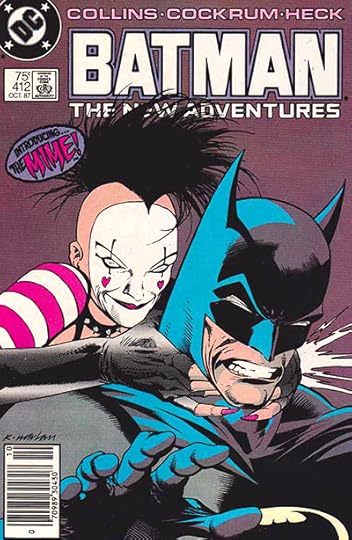
A week or so ago, people started telling me I’m mentioned in the end credits of The Lego Batman Movie. Well, that’s all it takes to get me to a movie!
I’d already been invited to the world premiere in Los Angeles, but somehow DC Comics neglected to send us plane tickets, so Barb and I passed.
This mention in the end credits of this fun, funny film came as a surprise, and a cool one. It comes fast right toward the very end, and you may miss it, because I’m one of a lot of Batman writers and artists thanked. A good number aren’t listed, like my pal Terry Beatty, who worked on more Batman stuff than me by a long shot (it was always a mildly bitter irony that the Collins/Beatty team’s two members each worked on BATMAN projects but never together…though we tried with several rejected projects, one of which prefigured the animated show’s approach).
Terry was the one who figured out why I made an esteemed list that included such greats as Dick Sprang, Jerry Robinson and Neal Adams. I created two characters – one of the versions of Robin (the least popular of all time!) and the villain the Mime, who appears in the film. Check it out here.
Ironies abound. I quit the Batman comic book because the Mime premise (if not the character) was mishandled by the artist. I had written that in search of the Mime, the police had rounded up suspects – and I specifically said all of them would look identical, specifically stereotypical mimes. The artist decided to vary them, tall, short, fat, etc., ruining the gag.
I’d had it and, after a frustrating year or so, I quit…probably an instant before I’d have been fired, but I quit.
That issue’s Batman script was not the last I wrote, however, as the follow-up had the Mime meeting the Joker. It never went into production, however, and I wound up turning it into a short story for a Batman anthology, The Further Adventures of Batman (1989), “The Sound of One Hand Clapping.” The book, with my story singled out, is reviewed here.
Some oh-so-serious Batman fans hate the Mime character, although she clearly prefigures the popular Harley Quinn. These fans of the dark Dark Knight version of the character can’t abide that I brought humor to the mix, since Batman – the story of a guy who dresses up in a costume with bat ears and a cape and refuses to use a gun as he fights crime in the big city – is so obviously a deadly serious premise. Not at all something a couple of kids named Bob and Bill dreamed up for other kids back in the late ‘30s. Such “Bat fans” are seriously in need of therapy. I recommend Arkham Asylum.
And now my revenge: the Mime and I are in a Batman movie!
Briefly, and for no money at all, I grant you…but in it! And I’m ridiculously pleased.

* * *
Nice Quarry TV write-up here.
Here’s another good one, which includes all the special features, including an in-depth interview with me…no, wait, it doesn’t, because I wasn’t asked.
Here’s an interesting review of Mickey Spillane’s The Twisted Thing from top-notch writer, James Reasoner.
And for some context, my take on The Twisted Thing for the Rap Sheet back in 2008 is here.
M.A.C.
February 14, 2017
Long and Winding Road

Paperback:




Thanks to all of you who responded warmly to my update last week about the recently published “new and expanded” Road to Perdition prose novel. The sequel, Road to Purgatory, has just been reprinted by Brash Books in a uniform edition, and Road to Paradise will follow later this year or early next.
So, with your patience, I’ll talk a little about how Road to Purgatory came about, and the challenges involved.
The original graphic novel concept of Road to Perdition was developed for DC Comics editor Andy Helfer. Initially the plan was to do three 300-page graphic novels, each serialized in 100-page installments (the final book as published is in 100-page sections), for an epic 900 pages. I had been in part inspired by the great manga, Lone Wolf and Cub, and the epic nature of that work was something to aspire to.
Andy Helfer and I, however, had not come to terms with what the next two 300-page installments would be. I wanted to keep the father and son outlaws on the road for the full 900-pages, with various adventures not unlike the format of the classic TV series, The Fugitive. Andy had another idea – he thought I should do a generational saga, with Michael Jr. growing up in the middle section, and either aging him further in the final section or following another generation of O’Sullivans into a world of crime and vengeance and (maybe) redemption.
The more I mentally chewed on it, the more Andy’s notion made sense. I still liked my idea, and greedily thought about doing both – a long road saga with Michael O’Sullivan Sr. and son, and a generational saga that grew out of it.
This all became a moot point when DC’s Paradox Press line, designed to do noir graphic novels, sputtered to a premature death. Road to Perdition was the last graphic novel Paradox Press published, so any follow-ups seem unlikely.
Of course Richard and Dean Zanuck deciding to make a movie out of Road to Perdition was even more unlikely, and yet it happened.
With the movie in production, and having written the novelization (even if it was published in a truncated form…until just lately), I thought writing prose sequels, as opposed to graphic novel ones, made the most sense.
Why didn’t I write another graphic novel? Actually, I did – Road to Perdition 2: On the Road (from DC) played out my idea of showing the father and son on the road having adventures while fleeing the wrath of the Chicago mob.
But the generational saga, it seemed to me, would be better served by prose. Also, I was in the position of being primarily a prose writer of crime and mystery fiction, and suddenly the most famous thing I’d ever written was a comic book. I wanted to bring a wider audience to what I do most often: prose novels, where the readers have to provide the pictures in their heads.
Also, I knew I could get a prose sequel (Road to Purgatory) into the marketplace sooner – striking while the iron is hot – rather than go through the longer process of creating a graphic novel. My great collaborator, Richard Piers Rayner, had taken over four years to draw the 300 pages of Road to Perdition.
Another challenge was what to do about the differences between the film version of Perdition and the original graphic novel. I could only write a sequel to the latter – any changes Hollywood had made belonged to them, and anyway, I preferred my own version. The two major changes were the dramatic killing off of John Looney (Rooney in the film) and the inability of Michael Jr. to kill the man who had shot his father. In my world, John Looney didn’t die until many years later (since he was an historical figure and I like to stay true to history) and Michael Jr. indeed shot his father’s killer. His redemption came, not from his dying father doing the killing for him, but many years later.
I dance around this in the novel – I even do some dancing in my Perdition prose novel, which suggests that maybe Michael Jr. did shoot his father’s killer. In my novel Road to Purgatory I own up to that, but suggest that others have assumed the father did the killing. And I don’t mention the real circumstances of John Looney’s death.
That way someone who comes to the three prose novels will not experience jarring differences between the first and second book.
As some of you know, there is also a graphic novel called Return to Perdition, drawn by my longtime Ms. Tree partner, Terry Beatty. This indeed pays off editor Andy Helfer’s generational saga notion by following the story of Michael Jr.’s son in Vietnam and beyond. Some have suggested that I might write a prose version of that story – which I view as a kind of coda to the three prose novels – but it’s unlikely.
Why in doing the last chapter of the saga did I return to the original graphic novel form? Simple. I pitched it to the publisher of the two prose sequels and they weren’t interested. But DC Comics was. So it became a graphic novel.
It isn’t always about “what’s the ideal way to tell the story.” It’s often, who will pay me money to tell the story? That’s why I have gone out of my way to master, as best I can, not only the novel form but comics and movies and for that matter TV. More bites at the apple.
Working in the arts fulltime requires a grasp of reality. For example, I had proposals written for both Road to Purgatory and ROAD TO PARADISE, but did not submit them to a publisher until the movie had come out. In fact, I had to wait to see if the movie opened big before my agent would even contemplate approaching a publisher. When Road to Perdition had a hugely successful opening weekend, we submitted to multiple houses and had an auction with numerous offers. A week before we would have been lucky to get any offer. Reality.
One key thing I failed to mention last week about The New and Expanded Road to Perdition. It’s a simple fact about movie novelizations that seldom gets discussed: when a writer does a novelization of a film, he or she works from the screenplay and almost never has access to anything else. Sometimes some stills from the set are provided, but the writer never sees the movie before writing the novel.
I admit to being proud of myself when I re-read the complete novelization, in getting it prepared to finally be published by Brash Books. The novel really captures the film…and I hadn’t seen it! I “directed” from the screenplay something very similar to the film version that Sam Mendes directed. That alone makes the Perdition prose novel my proudest achievement in the movie tie-in field…particularly now that you can read it!
Road to Purgatory is available right now from Amazon, Barnes & Noble, BAM! and the usual suspects. Your favorite independent bookstore can also order it for you, if you would care to support them, which is a good idea.
* * *
The positive reviews on the Quarry Blu-ray keep coming in. Here’s one.
And this one includes a shot at winning the DVD set. [Note from Nate: Contest is for UK residents only.]
Same opportunity here. [Note from Nate: For UK residents only. Also, might be Blu-Ray? Not sure.]
M.A.C.
February 7, 2017
Road Trip
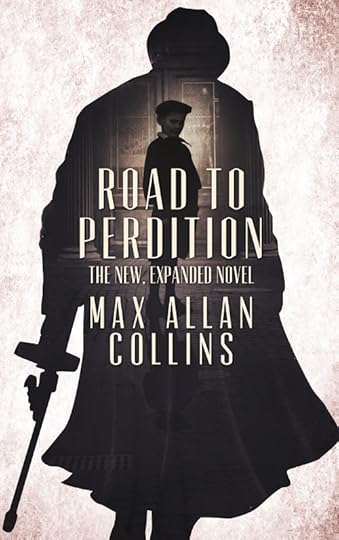
Paperback:




E-Book:




One of the nicest things that happened to me last year – acknowledging that 2016 was something of a mine field I barely navigated – was the first-time publication by Brash Books of my complete prose version of Road to Perdition.
Thus far, however, we don’t seem to have sold many copies, and at risk of a hard sell, I want to encourage readers of mine in general and of Road to Perdition in particular that this is a book you don’t want to miss.
Perhaps you’ve read the graphic novel and don’t see the point in revisiting this story, particularly if you’ve seen the movie. Or maybe you read the previously published version and figure that, even though it’s 30,000 words shorter, you’ve already experienced this story in prose.
You haven’t. The Brash publication of Road to Perdition brings into print (and e-book) one of my best novels. And it’s a novel that begins (and in this case completes) the trilogy of Road novels that includes both Road to Purgatory and Road to Paradise.
I should also make clear that the new Road to Perdition novel (and it’s “new” despite having been written in 2001) is not just 30,000 words longer – it’s a different novel entirely. To explain, I have to revisit the painful experience of writing it.
Knowing that someone would write the “novelization” of the film based on the graphic novel by Richard Piers Rayner and me – and being, at the time, a hot property among novelization writers – I lobbied to get the assignment myself. I had already done the very successful novelization for DreamWorks and NAL of Saving Private Ryan. It sold half a million copies and was on the New York Times bestseller list. I got the Perdition assignment.
My approach to writing a movie novelization (I hate that term!) is not entirely standard. Unlike a lot of tie-in writers, I throw out much of the dialogue and write my own. (I’ll speak in the present tense here, though it’s doubtful I’ll ever write another movie tie-in novel.) My reasoning is that movie dialogue and novel dialogue are two different animals. In addition, movie scenes – very short, often two pages or less – need fleshing out.
Similarly, movies tend to skip scenes and let the viewer fill in. A movie doesn’t have to explain how a bunch of characters got from point A to point D, because the movie depicts those characters at point D – so they must have got there, right? But in the novel version, I would write about getting from point A to point B and point C before doing point D. In other words, I add scenes.
I once had a call from director Jonathan Moslow, whose U-571 I had novelized. He told me how much he liked the book – this was the only such call I ever received, by the way – but wondered how I’d known to cut several scenes and also to add several others that had not been in the screenplay. I explained that, in my modest way, I was a filmmaker myself – that I’d directed a handful of indie features. And when I read certain scenes, I’d known they’d be skipped; and when I added certain scenes, I’d known they’d be needed…or at least would flesh out the narrative for a reader of the novel.
In Saving Private Ryan, I not only changed the dialogue and added scenes, I did considerable research and wove all kinds of factual material into the narrative. (Later, when I was signed to write the Windtalkers novel – about the Navajo code talkers – I was specifically asked to give that script the same Saving Private Ryan-style research-driven approach.)
What I had learned, doing a dozen or more novelizations, was that what the Hollywood folks wanted me to do was “follow the script out the door.” In other words, I needed to include every beat of action and narrative in the screenplay, preferably in the same order. A conversation about something could be in different words than the screenplay, as long as it appeared in the same place and covered the same ground.
So when I approached the novel version of Road to Perdition, I took my usual approach. I wrote my own dialogue, and I restored material from the graphic novel that had not been in the screenplay. I provided linking scenes. I also added a lot of period detail and historical material that hadn’t made it into the graphic novel, either. The memoir aspect of the graphic novel I restored by way of italicized first-person openings for each chapter.
The novel was substantial for a movie novelization – something like 80,000 words – and I was proud of it. Felt it was my best movie novel and that it was a real complement to the original graphic novel. I sent it to my agent, who liked it very much (and he’s a tough audience), and the tie-in editor at NAL said it was the best movie novelization he’d ever read. He was thrilled. Ecstatic.
Happy times at the Collins household.
Then the DreamWorks people got hold of the book. They were not pleased. They could not have cared less that I was the creator of the original material. What they wanted – what they demanded – was that all of the dialogue from the screenplay be included, exactly as written. They also wanted any material not in the screenplay removed.
I made my case through my agent, and later directly to the editor. But editors who have a movie novelization on their lists answer to the movie studio, who must sign off on the manuscript before publication. So those editors tend not to rock the boat. Whatever the studio wants, the studio gets.
I went through numerous rewrites. In the first of these I put the movie dialogue in, but retained the extended dialogue of my own that had lengthened the scenes fore and aft. This is a necessary novelization technique because movie scripts tend to run 100 to 120 pages, and by contract the novel usually must reach 300 pages. Simple math means that some material needs to be added.
Nonetheless, I was required to remove any dialogue that had not been in the screenplay. To get the book up to any sort of length at all, I changed patches of my dialogue into third-person interior monologue. That’s one of the reasons why the complete Perdition novel isn’t just longer than the previous version, but substantially different.
The craziness continued. As the movie went through various stages of post-production, I was required to cut any scenes that were cut as the film itself was tightened in editing. Most novelizations include scenes that were cut from the film, and that’s one of the fun of reading them – getting deleted scenes, so to speak. Such cutting made mincemeat of the novel – one chapter was reduced to a page and a half.
When the book was finally published in its truncated, bastardized form, the length was around 40,000 words. I thought of it was the Scholastic Books version. That it made the New York Times bestseller list was a bitter victory.
Throughout the process of aborting my own child, I was told that it was director Sam Mendes himself who was insisting on these changes. I’d met Mendes on set and had a long, friendly, even warm conversation with him. I found it hard to believe he’d behave in this fashion. At the London premiere, we spoke again, and one of the things he said was, “I understand you wrote the novelization. I can’t wait to read it.”
So.
If you like my work, if you like Road to Perdition in any of its previous forms, go to Amazon or Barnes & Noble or BAM! and order Road to Perdition: The New, Expanded Novel. You are unlikely to find the book in any brick-and-mortar store, but I do recommended the physical book over the e-book, as it’s a handsome thing.
[Note from Nate: Actually, buy digital, too, since the e-book is currently on sale for 99 cents on Amazon, Google Play, Kobo, and iTunes. Heck, buy it at all four — who knows, maybe you’ll switch devices one day!]
[Also, Indiebound is a service that helps readers find a local bookstore where the physical novel can be special ordered, often online. Here’s the link.]
The sequel, Road to Purgatory, is also a handsome thing, and it’s just been published by Brash. (Read about it here: http://www.brash-books.com/book/road-to-purgatory-coming-in-february-2017/) Brash will be doing Road to Paradise as well, later this year or early next. The books have lovely uniform covers and will make a nice set for you to place on your bookshelf next to Nate Heller, Quarry and Barbara Allan.
The joy of having the real Road to Perdition novel exist will be greatly amplified if some of you actually read it.
* * *
People are always asking me what I’ve been reading. I know they mean novels, but as I’ve said here many times, I rarely read novels, and when I do, they tend to be older ones (lately Simenon’s Maigret novels).
Here are a few recent reads, all non-fiction:
An Unseemly Man, Larry Flynt – prepping for a Quarry novel about a Flynt-like murder target. Frank and smart, with the court battles over First Amendment issues often riveting.
TV (The Book), Alan Sepinwall and Matt Zoller Seitz, opinions and history about “the greatest American shows of all time.” Spotty, but readable.
A Life in Parts, Bryan Cranston. I mentioned this before – an excellent memoir by the Breaking Bad actor.
James Bond: The Secret History, Sean Egan. A decent look at Fleming and Bond, the latter in comics and video games as well as film and novels. No sense at all of the role Spillane played in the creation of the character.
That Kind of Woman – The Life and Career of Barbara Nichols, Richard Koper. A sad, repetitive look at the actress’ life. A lot of work went into it, but not really a professional job. Tons of good photos, though.
Andy & Don, Daneil de Vise – excellent dual bio of Andy Griffith and Don Knotts. Griffith is a fascinating guy, with a “Lonesome” Rhodes dark side.
Spotlight and Shadows – The Albert Salmi Story (2nd Edition), a fine bio by Sandra Grabman of the great character actor whose end was heartbreakingly tragic.
Arthur and Sherlock, Michael Sims. A look at the creation of Holmes by Doyle, ultimately unsatisfying, a detailed bio of the author cutting off after the publication of the initial Holmes stories.
A Mysterious Something in the Night: The Life of Raymond Chandler, Tom Williams. A pretty good bio of Chandler, though unremittingly sad. But for a picture section photo cutline, strangely omits any mention of Murder, My Sweet (a key film) and barely mentions the remake Farewell, My Lovely. Also agrees with any literary opinion of the notoriously cranky Chandler in a knee-jerk fashion. Nonetheless, worthwhile.
Wild Wild Westerners, Tom Weaver. B-movie maven Weaver talks to nineteen actors, writers and directors from the heyday of western film and TV, with standout interviews with Fess Parke, Andrew J. Fenady and June Lockhart.
See? I read.
* * *
Comic Mix has a giveaway contest for a Blu-ray copy of the Quarry Cinemax show.
A wonderful write-up on the Blu-ray release of Quarry is at DVD Beaver, one of my favorite sites (and not a porn one, despite its name).
Finally, here’s another Quarry Blu-ray review (haven’t received a copy yet myself).
M.A.C.
January 31, 2017
Dinner With Perry and Della
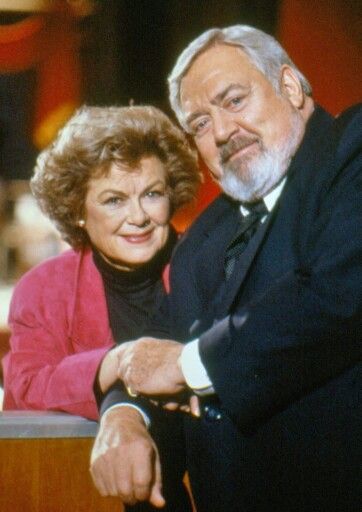
Barbara Hale is gone.
She was 94, so it’s not exactly a tragedy, but it still hurts. Few actresses have done more with so underwritten a part as Ms. Hale did with Della Street on Perry Mason. She brought humor and intelligence to the role, and her genuine connection with both Raymond Burr and William Hopper brought a sense of reality to a fairly ridiculous if enormously entertaining concept – the defense attorney who (almost) never loses a case.
I was lucky enough to meet Barbara Hale and spend some time with her. Here’s what happened.
Back in the late ‘80s, I got the chance to collaborate on a project with Raymond Burr. Now, coincidentally, I had for some time been collecting the old Mason shows on VHS, and reading the Erle Stanley Gardner novels as crime-fiction comfort food, even collecting Mason first editions. Barb was a fan of the TV show, too, so it was a mutual enthusiasm, which is always nice for husband and wife.
Getting the chance to meet Burr, and work with him, was a dream come true. I made three trips to Denver, where the Mason TV-movies were being shot, and spent a lot of time with Raymond (he preferred that to “Ray”). He was an interesting guy, warm and generous and puckishly funny. The high-end hotel where I was staying had a residential wing where Burr lived during production of the films. I went to his suite, knocked on the door, and he answered, wearing a railroad engineer’s cap and coveralls – he had an elaborate model railroad set-up that threaded through the various rooms of the apartment. And the trains were a rollin’!
He and I got along fine. The first trip we didn’t work – we just got to know each other, and he regaled me with tales of his long and fascinating, much-travelled life. I heard about the Ballets Russes, where his career had begun, and of such world figures as Madame Chiang Kai-shek, as well as his experiences touring with the USO in Vietnam. I told him we should just skip the idea of doing a thriller and put together his autobiography. But he was adamant that he would never write that book, after spending hours convincing me it would be important and fascinating. His bisexuality, which he fairly openly referred to in our conversations – his frankness was part of my acceptance as a friend – was something he never wished to discuss in public.
On the other two Denver trips, we worked – plotting an espionage thriller in the morning and over lunch, with me working several hours in the mid-afternoon in my hotel room to put our thoughts on paper, joining him again an hour or two before supper. Every meal I had on these trips was with Raymond.
One meal was particularly memorable. Barbara Hale was arriving to shoot the next Mason TV movie, which was about to begin production. Raymond asked me if I would like to meet her and go out with them for dinner at the best steakhouse in Denver. I would have gone to the worst diner in Paducah for a chance to do that. I called Barb and said, “Guess who I’m going out to dinner with tonight? Perry and Della!” She said she hated me, but sounded sweet saying so.
Barbara Hale would have been 66 at the time – two years younger than I am now – but I remember being almost startled by how lovely and young she seemed to me, and, frankly, sexy. She came across older on television in the Mason movies. There was a genuine chemistry between us, and the fact that I could make Della Street smile so easily was just about as good as it gets.
We definitely hit it off, and she was impressed that I knew about her career right down to her appearing in small roles in various RKO movies of the ‘40s, like The Great Gildersleeve entries. In the limo on the way to the steakhouse, sitting between her and Raymond like their overgrown child, I told Barbara how much I loved her in Jolson Sings Again. Raymond, with his ever-present twinkle, said, “Oh, I agree. She was wonderful getting down on her knees in blackface.” She giggled and batted his arm and he giggled back. These two loved each other. Was I really here?
At the steakhouse – where actor Tom Bosley (filming the Father Dowling mysteries in Denver) stopped by to pay his respects – we had a long dinner during which I questioned Raymond and Barbara incessantly about the original Mason show. I had brought along the hardcover first edition of a Mason novel that had Barbara and Raymond pictured together on the back cover – I got this signed by both of them. They had a great time reminiscing about the original show and I only wish I’d secretly recorded all of it.
The TV movie they were shooting, The Case of the Musical Murder, had Debbie Reynolds as a guest star, but she wasn’t around while I was. I did get to go on set several times and watch scenes being shot, and also had several nice conversations with William R. Moses, who had just begun playing Mason’s young assistant on the show. For the first nine movies, Barbara Hale’s son, William Katt, had played Paul Drake, Jr., and Moses was essentially replacing him. I didn’t know why and was tactful enough not to ask.
But I did, at our steakhouse dinner, tell Barbara in front of Raymond what a great job I thought her son had done in that role. She beamed at that. The next day, when Raymond and I picked her up at her suite for lunch, she took me aside and gave me a hug, and whispered, “Thank you for what you said about my son.” Katt, it turned out, had left the Mason movies for a (short-lived) series of his own, and apparently Raymond was not happy about it.
Still, the affection between the two performers was obvious. Raymond told me over lunch one day that he planned to end the series of movies with one in which Mason and Della finally got married. The films began to include genuine expressions of love between the characters, even a kiss or two (the original series had been much more coy about what was an obvious long ongoing relationship between boss and secretary).
Unfortunately the project with Raymond (and I do apologize for speaking of him so familiarly) did not go anywhere. The New York editor who had put us together wanted a mystery, and even suggested a courtroom-oriented one, with the world-hopping thriller we proposed not doing the trick. The editor clearly wanted something like Perry Mason or Ironside. Raymond Burr, with all his international interests and travels, wanted something wider-ranging and in the espionage field. I later learned that two other writers were put together with Raymond Burr and in each case the actor’s strong personality guided them to espionage, and each time the New York editor bridled.
Of course Perry and Della never got married. Raymond Burr’s death in 1993 pre-empted that.
While I regret I never shared the Burr byline on a book or even series of books, I still relish the memory of the collaboration.
After all, it’s not everybody who gets to spend an evening with Perry and Della.
* * *
Arrow is giving some info about Wild Dog’s origin. Still haven’t watched an episode.
Here’s a fun look at Mike Hammer in the movies and on TV (though the writer, who quotes me occasionally, does not seem to have read Mickey Spillane on Screen by Jim Traylor and me).
Here’s an article about the Quarry books and a discussion about what order to read them in, with several options.
Finally, here’s an essay that thinks Cinemax ought to give Quarry a second season. My bank account agrees!
M.A.C.



